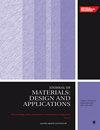印刷碳纤维增强聚乳酸和 PETG 复合材料的机械性能
IF 2.2
4区 材料科学
Q3 MATERIALS SCIENCE, MULTIDISCIPLINARY
Proceedings of the Institution of Mechanical Engineers, Part L: Journal of Materials: Design and Applications
Pub Date : 2024-01-08
DOI:10.1177/14644207231225761
引用次数: 0
摘要
本研究采用三维打印技术生产碳纤维增强聚乳酸和聚对苯二甲酸乙二醇复合材料。在不同的打印参数设置下,特别是光栅角度、打印速度和挤出温度下,进行了熔融沉积建模过程。在逐层沉积质量和机械性能方面,所选的每个印刷参数都对制造最佳印刷部件起着关键作用。为了研究这些工艺参数如何影响印刷部件的性能,对其进行了拉伸试验和机械性能评估。结果表明,以光栅角为特征的印刷方向是确定断裂模式的决定性因素。光栅角为 0°、与拉伸加载路径一致的印刷复合材料部件具有最高的刚度和延展性。通过对断裂剖面的光学观察,可以看到与 0° 和 90° 光栅角分别对应的韧性断裂和脆性断裂。此外,拉伸试验表明,印刷速度越快,机械性能越差,印刷结构的刚度明显降低。扫描电子显微镜分析证实,提高印刷速度会导致结构内部孔隙增加,从而削弱其机械强度。关于挤压温度,研究表明,提高挤压温度可以增强印刷部件的机械性能,特别是在强度和延展性方面。根据微观结构观察,这一结果归因于在高挤压温度下,沉积层之间的附着力得到改善,孔隙率降低。本文章由计算机程序翻译,如有差异,请以英文原文为准。
Mechanical performances of printed carbon fiber-reinforced PLA and PETG composites
In this study, the 3D printing technology was adopted to produce carbon fiber-reinforced polylactic acid and polyethylene terephthalate glycol composites. Fused deposition modeling process was conducted at different settings of printing parameters, specifically, raster angle, printing speed, and extrusion temperature. Each of the selected printing parameters has a key role in making the best-printed part in terms of layer-by-layer deposition quality and mechanical performance. To examine how these process parameters affect the behavior of the printed parts, tensile tests were performed and mechanical properties were assessed. It was reported that the printing orientation, characterized by the raster angle, can be identified as the determining factor to define the fracture mode. Composite parts printed with 0° raster angle, aligning with the tensile loading path, exhibit the highest levels of stiffness and ductility. Ductile and brittle fractures corresponding to 0° and 90° raster angles, respectively, were illustrated through optical observations of failure profiles. Furthermore, the tensile test indicates that higher printing speed leads to a significant deterioration in mechanical performances, notably reducing the stiffness of the printed structures. Scanning electron microscopy analysis confirmed that increasing the printing speed results in greater porosity within the structure, thereby weakening its mechanical strength. Regarding the extrusion temperature, it was shown that elevating it enhances the mechanical characteristics of the printed parts, particularly in terms of strength and ductility. Referring to microstructural observations, this outcome is attributed to the improved adhesion between the deposited layers and the reduction in porosity at high extrusion temperature.
求助全文
通过发布文献求助,成功后即可免费获取论文全文。
去求助
来源期刊

CiteScore
4.70
自引率
8.30%
发文量
166
审稿时长
3 months
期刊介绍:
The Journal of Materials: Design and Applications covers the usage and design of materials for application in an engineering context. The materials covered include metals, ceramics, and composites, as well as engineering polymers.
"The Journal of Materials Design and Applications is dedicated to publishing papers of the highest quality, in a timely fashion, covering a variety of important areas in materials technology. The Journal''s publishers have a wealth of publishing expertise and ensure that authors are given exemplary service. Every attention is given to publishing the papers as quickly as possible. The Journal has an excellent international reputation, with a corresponding international Editorial Board from a large number of different materials areas and disciplines advising the Editor." Professor Bill Banks - University of Strathclyde, UK
This journal is a member of the Committee on Publication Ethics (COPE).
 求助内容:
求助内容: 应助结果提醒方式:
应助结果提醒方式:


